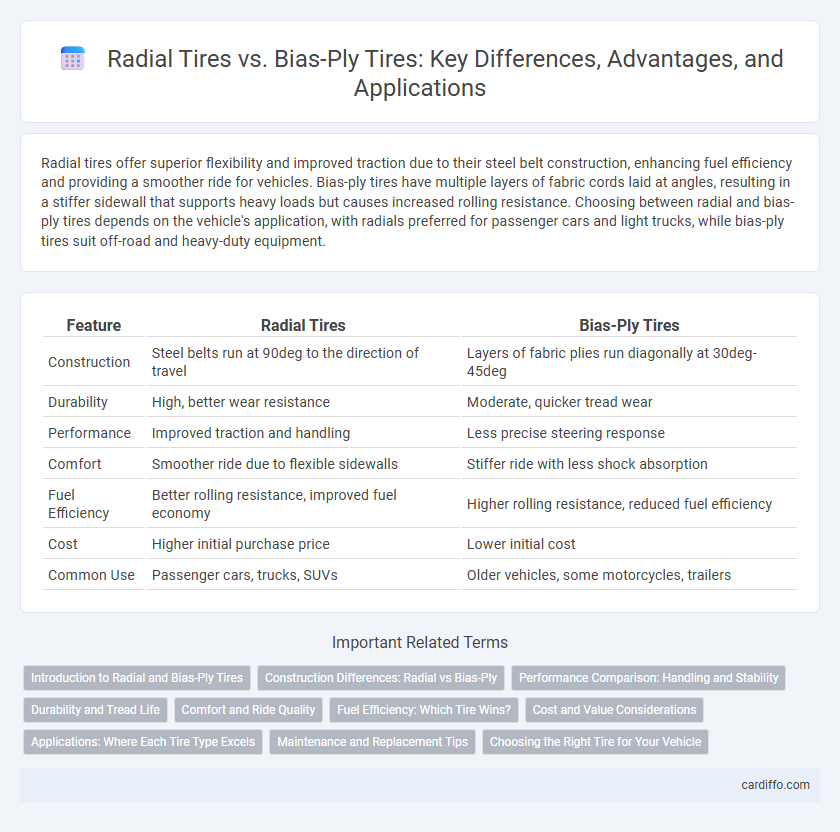Radial tires offer superior flexibility and improved traction due to their steel belt construction, enhancing fuel efficiency and providing a smoother ride for vehicles. Bias-ply tires have multiple layers of fabric cords laid at angles, resulting in a stiffer sidewall that supports heavy loads but causes increased rolling resistance. Choosing between radial and bias-ply tires depends on the vehicle's application, with radials preferred for passenger cars and light trucks, while bias-ply tires suit off-road and heavy-duty equipment.
Table of Comparison
| Feature | Radial Tires | Bias-Ply Tires |
|---|---|---|
| Construction | Steel belts run at 90deg to the direction of travel | Layers of fabric plies run diagonally at 30deg-45deg |
| Durability | High, better wear resistance | Moderate, quicker tread wear |
| Performance | Improved traction and handling | Less precise steering response |
| Comfort | Smoother ride due to flexible sidewalls | Stiffer ride with less shock absorption |
| Fuel Efficiency | Better rolling resistance, improved fuel economy | Higher rolling resistance, reduced fuel efficiency |
| Cost | Higher initial purchase price | Lower initial cost |
| Common Use | Passenger cars, trucks, SUVs | Older vehicles, some motorcycles, trailers |
Introduction to Radial and Bias-Ply Tires
Radial tires feature steel belts that run perpendicular to the tread, offering enhanced flexibility, improved fuel efficiency, and superior traction compared to bias-ply tires, which have crisscrossed layers of fabric that provide a stiffer sidewall and greater durability on rough surfaces. Radial designs optimize road contact and heat dissipation, making them ideal for modern vehicles requiring durability and performance. Bias-ply tires maintain strength under heavy loads and harsh conditions but tend to wear faster and reduce handling precision.
Construction Differences: Radial vs Bias-Ply
Radial tires feature cords arranged at a 90-degree angle to the tread, providing improved flexibility and better road contact, while bias-ply tires have cords layered diagonally at 30-40 degrees, resulting in a stiffer sidewall and increased heat generation. The radial construction allows for enhanced durability and fuel efficiency, whereas bias-ply tires offer stronger resistance to cuts and impacts due to their layered build. These construction differences significantly affect tire performance, handling, and lifespan on various road surfaces.
Performance Comparison: Handling and Stability
Radial tires provide superior handling and stability due to their flexible sidewalls and stiff tread design, which maximize road contact and reduce heat buildup. Bias-ply tires, with crisscrossed layers of ply cords, offer less precise steering response and increased rolling resistance, affecting overall stability. Performance tests consistently show radial tires excel in cornering grip and ride comfort, making them the preferred choice for modern vehicles.
Durability and Tread Life
Radial tires offer superior durability compared to bias-ply tires due to their construction, which allows for better heat dissipation and reduced tread wear. The flexible sidewalls of radial tires enhance tread life by maintaining more consistent contact with the road surface, decreasing uneven wear. Bias-ply tires typically wear out faster because their stiffer sidewalls cause higher friction and less efficient heat management.
Comfort and Ride Quality
Radial tires provide superior comfort and ride quality due to their flexible sidewalls, which absorb road shocks more effectively than bias-ply tires. Bias-ply tires have stiffer sidewalls, resulting in a rougher ride and less cushioning over uneven surfaces. This makes radial tires a preferred choice for passenger vehicles aiming for smooth handling and reduced vibration.
Fuel Efficiency: Which Tire Wins?
Radial tires enhance fuel efficiency due to their flexible sidewalls and lower rolling resistance, leading to better traction and reduced energy consumption. Bias-ply tires, with their stiffer construction, generate higher rolling resistance, causing increased fuel consumption. Studies show radial tires can improve fuel economy by up to 10% compared to bias-ply tires, making them the superior choice for fuel savings.
Cost and Value Considerations
Radial tires generally offer better long-term value due to improved fuel efficiency, longer tread life, and enhanced performance but come at a higher initial cost compared to bias-ply tires. Bias-ply tires are typically less expensive upfront and can be more durable in heavy-duty applications or off-road conditions, making them cost-effective for specific uses. Evaluating the total cost of ownership, including replacement frequency and fuel savings, is crucial when comparing radial and bias-ply tires for optimal value.
Applications: Where Each Tire Type Excels
Radial tires excel in passenger cars, light trucks, and highway driving due to their superior fuel efficiency, better tread life, and enhanced handling. Bias-ply tires perform well in off-road vehicles, agricultural equipment, and heavy-duty trucks, offering increased durability and resistance to impact damage on rough terrain. Choosing the right tire depends on the specific application requirements, such as load capacity, road conditions, and driving style.
Maintenance and Replacement Tips
Radial tires offer longer tread life and improved durability compared to bias-ply tires, reducing the frequency of replacements and maintenance. Regularly check tire pressure and alignment to maximize performance and prevent uneven wear on radial tires, essential for safety and cost-efficiency. Bias-ply tires require more frequent inspections for sidewall cracking and tread wear, with replacements recommended sooner due to their construction and reduced lifespan.
Choosing the Right Tire for Your Vehicle
Radial tires provide superior traction, fuel efficiency, and longer tread life compared to bias-ply tires, making them ideal for everyday driving and high-speed performance. Bias-ply tires offer enhanced sidewall strength and durability, which suits heavy-duty vehicles and off-road conditions. Selecting the right tire depends on your vehicle type, driving habits, and road conditions, ensuring optimal safety and performance.
Radial tires vs bias-ply tires Infographic

 cardiffo.com
cardiffo.com